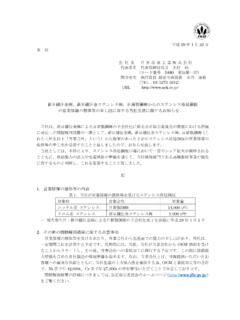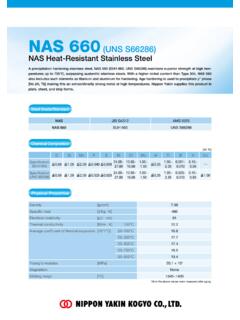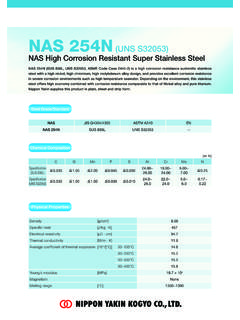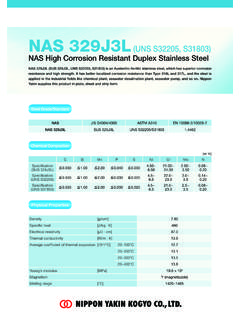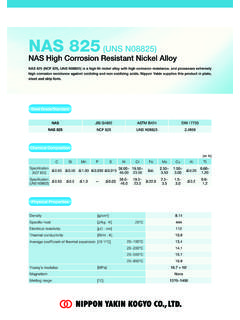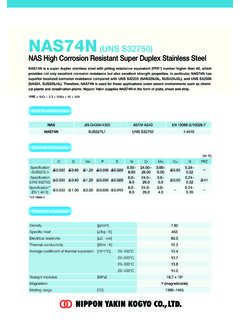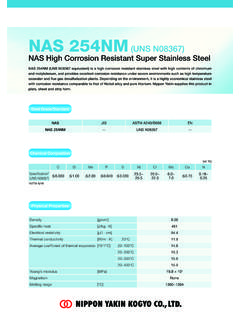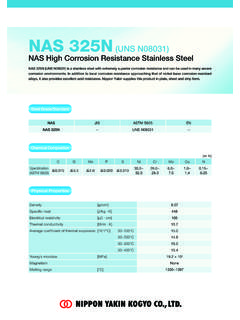Transcription of NAS 255 - 日本冶金工業
1 nas 255 (UNS N08904, SUS 890L) is an austenitic stainless steel with superior corrosion resistance in comparison with Type 316L. Due to addition of Cu ( ), this material displays excellent corrosion resistance against reducing acids such as sulfuric acid and phosphoric acid. It is used in chemical plants and a wide range of other applications. Nippon Yakin supplies this product in plate, sheet and strip 255 (UNS N08904)NAS High Corrosion Resistant Stainless SteelNASJIS G4304/4305 ASTM A240 ENNAS 255 SUS 890 LUNS Grade/Standard[wt %]CSiMnPSNiCrMoCuNSpecification (SUS 890L) ~ ~ ~ ~ Specification (UNS N08904) ~ ~ ~ ~ CompositionDensity[g/cm3] heat[J/kg . K]452 Electrical resistivity[ . cm] conductivity[W/m . K] coefficient of thermal expansion[10 6/ C]20~100 ~200 ~300 ~400 s modulus[MPa] 104 MagnetismNoneMelting range[ C]1360~1397 Physical PropertiesMechanical PropertiesMechanical Properties at Room proof stress[MPa]Tensile strength[MPa]Elongation[%]Hardness[HRB]S pecification (SUS 890L)2154903590 Specification (UNS N08904) 2204903590 ExampleHot-rolled plate 12mmt2475935786 Cold-rolled sheet 2mmt2916324379 Because NAS255 contains high concentrations of chromium, nickel and molybde-num, it offers excellent pitting corrosion resistance, crevice corrosion resistance, stress corrosion cracking (SCC) resistance and acid resistance in comparison with Type 304 and Type ResistancePitting Corrosion ResistanceAlloyASTM G48 Method AASTM G48 Method C22 C50 CCritical pitting corrosion temperature CPT ( C)SUS 304 10 SUS 316L 15 nas 255 50 Test conditions ASTM G48 Method A (.)
2 No pitting corrosion, : Pitting corrosion) ASTM G48 Method C Test solution: 6%FeCl3 Test solution: 6%FeCl3 + 1%HCl Test temperature: 22 C, 50 C (Recommended temperature in this test) Test time: 72h Test time: 72hCrevice Corrosion ResistanceAlloyASTM G48 Method DCritical crevice corrosion temperature CCT ( C)SUS 304< 10 SUS 316L< 10 NAS 25510 Test conditions ASTM G48 Method D Test solution: 6%FeCl3 + 1%HCl Test time: 72hNAS 255 (UNS N08904) nas 255 (UNS N08904)Stress Corrosion Cracking ResistanceAlloyMgCl2 concentration (boiling point ( C) are in brackets)45%(155 C)42%(143 C)40%(138 C)38%(134 C)35%(126 C)30%(115 C)25%(110 C)20%(108 C)SUS 304 SUS 316L nas 255 Test conditions Immersion in boiling MgCl2 solution : No stress corrosion cracking Test time: 300h : Stress corrosion cracking U-bend test specimen is ResistanceAlloyCorrosion rate in sulfuric acid at 80 C (mm/y)5%10%20%40%60%80%SUS 255< < time: 24hAlloyCorrosion rate in hydrochloric acid at 80 C (mm/y) 255< time: 24h(Reference)Nippon YakinJISUNS compositionSUS 304 SUS 304S3040018Cr-8 NiSUS 316 LSUS 316LS3160317Cr-12Ni-2 MoNAS 255 SUS and hot workability are approximately equal to those of Type 304, 316, and other standard austenitic stainless is on the same level as ordinary austenitic stainless steels.
3 Preheating and post-heating are not necessary. As welding electrodes, in applications under severe corrosion environments, use of welding consumables with equal or higher corrosion resistance is recommended. When the corrosion environment is not severe, and when the purpose of welding is for joining, matching welding consum-ables may be annealing of nas 255 should be performed at 1095 C and higher followed by being quenched in water or rapidly cooled by other means. (Conditions provided in ASTM A480/A480M)Heat TreatmentA mixture of nitric acid and hydrofluoric acid is used in pickling. However, due to the high corrosion resistance of nas 255 , scale is somewhat difficult to remove in comparison with Type 304. Therefore, the material should be immersed in an alkaline solution before pickling, or if possible, shot blasting is extremely acid and phosphoric acid plants, seawater heat exchangers, chemical plants, food plants, more information, please contact: Nippon Yakin Kogyo Co.
4 , Solutions Sales DepartmentSan-Ei Bldg., 5-8, 1-chome Kyobashi, Chuo-ku, Tokyo 104-8365 JapanTEL: +81-3-3273-4649 FAX: +81-3-3273-4642E-Mail: regarding the handling of property data:The technical information contained in this product guide is representative values obtained in property tests and other items used to explain the per-formance of the product. With the exception of items specifically mentioned as provisions of a Standard, the contents do not represent guaranteed upper limit or lower limit values. The respective data given on this technical information are typical examples and may be different in some cases from the data obtained from the actual product. No responsibility shall, therefore, be assumed for damages arising from using the technical information data. This information is also subject to change in the future without notice.
5 To obtain the most recent information, please contact Nippon 255 (UNS N08904)
